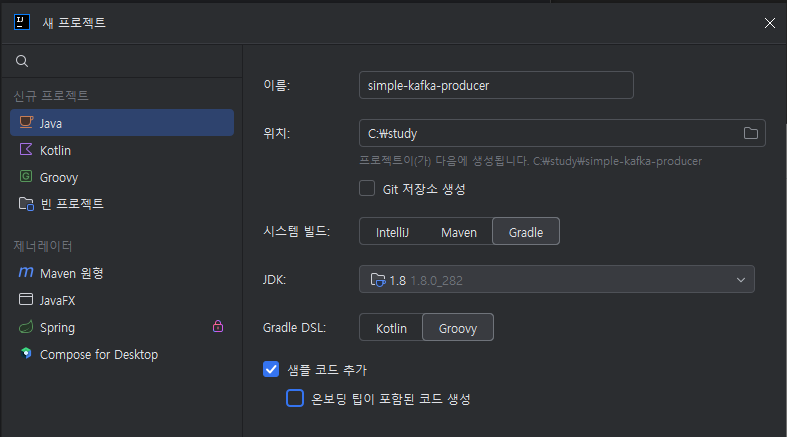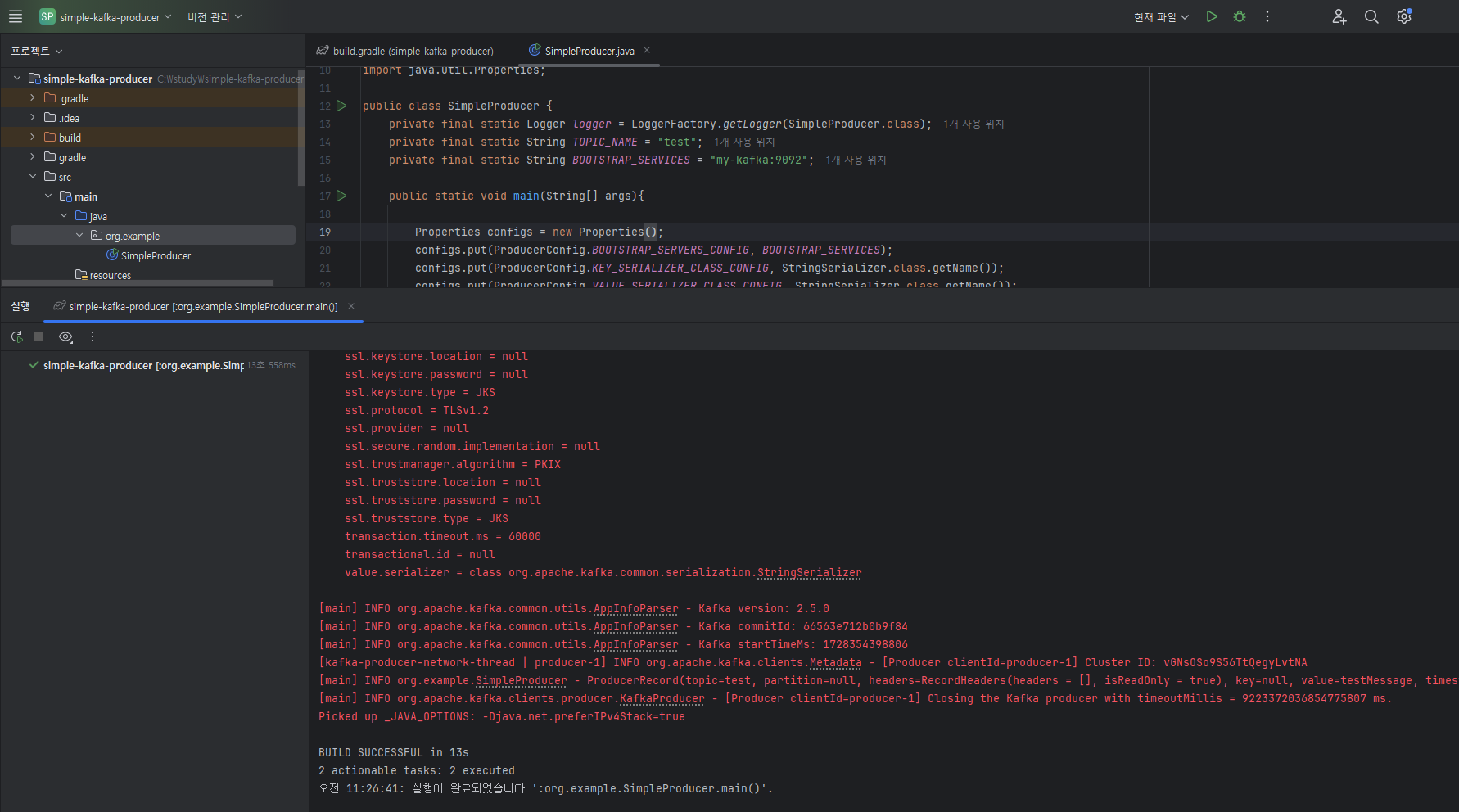# 카프카 클라이언트
# 프로듀서 프로젝트 생성
- 프로젝트 생성

- 카프카 클라이언트 라이브러리 추가
build.gradle
dependencies {
implementation 'org.apache.kafka:kafka-clients:2.5.0'
implementation 'org.slf4j:slf4j-simple:1.7.30'
}
1
2
3
4
2
3
4
- SimpleProducer.java 소스 작성
public class SimpleProducer {
private final static Logger logger = LoggerFactory.getLogger(SimpleProducer.class);
private final static String TOPIC_NAME = "test";
private final static String BOOTSTRAP_SERVICES = "my-kafka:9092";
public static void main(String[] args){
Properties configs = new Properties();
configs.put(ProducerConfig.BOOTSTRAP_SERVERS_CONFIG, BOOTSTRAP_SERVICES);
configs.put(ProducerConfig.KEY_SERIALIZER_CLASS_CONFIG, StringSerializer.class.getName());
configs.put(ProducerConfig.VALUE_SERIALIZER_CLASS_CONFIG, StringSerializer.class.getName());
KafkaProducer<String, String> producer = new KafkaProducer<>(configs);
String messageValue = "testMessage";
ProducerRecord<String, String> record = new ProducerRecord<>(TOPIC_NAME,messageValue);
producer.send(record);
logger.info("{}",record);
producer.flush();
producer.close();
}
}
1
2
3
4
5
6
7
8
9
10
11
12
13
14
15
16
17
18
19
20
21
22
23
2
3
4
5
6
7
8
9
10
11
12
13
14
15
16
17
18
19
20
21
22
23
- 토픽 생성
bin/kafka-topics.sh --bootstrap-server my-kafka:9092 --create --topic test --partitions 3
1
클라이언트 소스 실행
![15]()
토픽에 데이터 전송 확인
bin/kafka-console-consumer.sh --bootstrap-server my-kafka:9092 --topic test --from-beginning
1
# 메시지 키를 가진 데이터를 전송하는 프로듀서
# 메시지 키가 포함된 레코드를 전송하고 싶다면 ProducerRecords 생성시 파라미터로 추가
ProducerRecord<String,String> record = new ProducerRecord<>("test","Pangyo","23");
1
클라이언트 실행
# 메시지 키가 지정된 데이터 확인
bin/kafka-console-consumer.sh --bootstrap-server my-kafka:9092 --topic test --property print.key=true --property key.separator="-" --from-beginning
1
# 파티션을 직접 지정하고 싶다면
토픽이름, 파티션번호, 메시지키, 메시지 값을 순서대로 파라미터로 넣고 생성.
ProducerRecord<String,String> record = new ProducerRecord<>(TOPIC_NAME, partitionNo, messageKey, messageValue);
1
# 커스텀 파티셔너를 가지는 프로듀서
- 기본 파티셔너를 사용할 경우 메시지의 키의 해시값을 파티션에 매칭하여 데이터를 전송하므로 어느 파티션에 들어가는지 알 수 었다.
- Partitioner 인터페이스를 사용하여 사용자 정의 파티셔너를 생성하면 파티션 지정 가능
public class CustomPartitioner implements Partitioner {
@Override
public int partition(String topic, Object o, byte[] keyBytes, Object key, byte[] bytes1, Cluster cluster) {
if(keyBytes == null) {
throw new InvalidRecordException("Need Message Key");
}
if(((String)key).equals("Pangyo")) {
return 0;
}
List<PartitionInfo> partitions = cluster.partitionsForTopic(topic);
int numPartitions = partitions.size();
return Utils.toPositive(Utils.murmur2(keyBytes))%numPartitions;
}
@Override
public void close() {
}
@Override
public void configure(Map<String, ?> map) {
}
}
1
2
3
4
5
6
7
8
9
10
11
12
13
14
15
16
17
18
19
20
21
22
23
24
25
2
3
4
5
6
7
8
9
10
11
12
13
14
15
16
17
18
19
20
21
22
23
24
25
public class SimpleProducer {
private final static Logger logger = LoggerFactory.getLogger(SimpleProducer.class);
private final static String TOPIC_NAME = "test";
private final static String BOOTSTRAP_SERVICES = "my-kafka:9092";
public static void main(String[] args){
Properties configs = new Properties();
configs.put(ProducerConfig.BOOTSTRAP_SERVERS_CONFIG, BOOTSTRAP_SERVICES);
configs.put(ProducerConfig.KEY_SERIALIZER_CLASS_CONFIG, StringSerializer.class.getName());
configs.put(ProducerConfig.VALUE_SERIALIZER_CLASS_CONFIG, StringSerializer.class.getName());
// 커스텀 파티셔너를 지정한 경우 옵션을 사용자 생성 파티셔너로 설정하여 kafkaProducer 인스턴스를 생성해야 한다.
configs.put(ProducerConfig.PARTITIONER_CLASS_CONFIG, CustomPartitioner.class);
KafkaProducer<String, String> producer = new KafkaProducer<>(configs);
ProducerRecord<String,String> record = new ProducerRecord<>("test","Pangyo","23");
producer.send(record);
logger.info("{}",record);
producer.flush();
producer.close();
}
}
1
2
3
4
5
6
7
8
9
10
11
12
13
14
15
16
17
18
19
20
21
22
23
24
2
3
4
5
6
7
8
9
10
11
12
13
14
15
16
17
18
19
20
21
22
23
24
# 브로커 정상 여부를 확인하는 프로듀서
# 동기 결과 확인
RecordMetadata metadata = producer.send(record).get(); // 결과를 동기적으로 가져올 수 있다.
logger.info(metadata.toString());
1
2
2
# 비동기 결과 확인 Callback 인터페이스
사용자 정의 callback 클래스를 생성하여 레코드의 전송 결과에 대응하는 로직을 만들 수 있다.
public class ProducerCallback implements Callback {
private final static Logger logger = LoggerFactory.getLogger(ProducerCallback.class);
@Override
public void onCompletion(RecordMetadata recordMetadata, Exception e) { // 레코드의 비동기 결과를 받음.
if(e != null) {
logger.error(e.getMessage(), e);
} else {
logger.info(recordMetadata.toString());
}
}
}
1
2
3
4
5
6
7
8
9
10
11
12
2
3
4
5
6
7
8
9
10
11
12
public static void main(String[] args) throws ExecutionException, InterruptedException {
Properties configs = new Properties();
configs.put(ProducerConfig.BOOTSTRAP_SERVERS_CONFIG, BOOTSTRAP_SERVICES);
configs.put(ProducerConfig.KEY_SERIALIZER_CLASS_CONFIG, StringSerializer.class.getName());
configs.put(ProducerConfig.VALUE_SERIALIZER_CLASS_CONFIG, StringSerializer.class.getName());
configs.put(ProducerConfig.PARTITIONER_CLASS_CONFIG, CustomPartitioner.class);
KafkaProducer<String, String> producer = new KafkaProducer<>(configs);
String messageValue = "testMessage";
ProducerRecord<String,String> record = new ProducerRecord<>("test","Pangyo","26");
producer.send(record, new ProducerCallback());
logger.info("{}",record);
producer.flush();
producer.close();
}
1
2
3
4
5
6
7
8
9
10
11
12
13
14
15
16
17
2
3
4
5
6
7
8
9
10
11
12
13
14
15
16
17
← 카프카 커맨드라인 툴 컨슈머 API →

